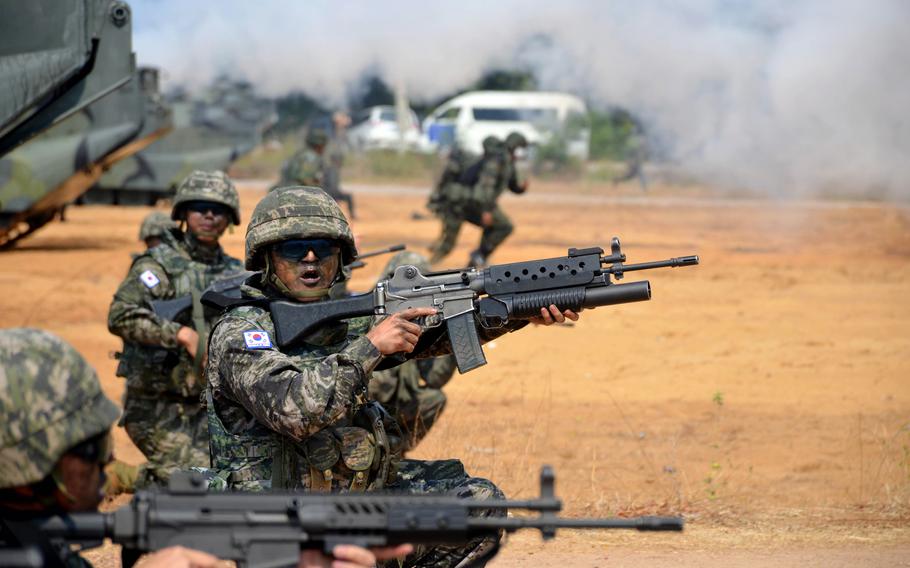
South Korean troops form a line during an amphibious assault on Hat Yao Beach, Thailand, March 1, 2024, as part of the Cobra Gold exercise. (Alex Wilson/Stars and Stripes)
HAT YAO BEACH, Thailand — U.S. F-16 Fighting Falcons making simulated airstrikes split the quiet on the beach here Friday, signaling the start of a massive amphibious exercise by more than 2,000 U.S., Thai and South Korean troops.
Ahead of the F-16s, Thai marine special operators stormed ashore in rigid inflatable boats, while U.S. paratroopers carefully descended near smoke signals in the first wave. Within minutes, nearly 20 amphibious vehicles from all three countries lumbered onto the beach and unloaded hundreds of troops.
They advanced and fired blanks, but with no enemy to halt their advance, the mock battle ended swiftly.
The exercise marked a significant, early piece of Cobra Gold, one of the largest military exercises in Asia and now in its 43rd year, according to Rear Adm. Christopher Stone, commander of the U.S. Navy’s Task Force 76/3. The drills began Feb. 27 and concludes Thursday.
“This year we have seven full-participating countries, and we have three limited-participation navies, but broadly, we have 30 nations represented and working together in Cobra Gold,” he told reporters before the drill. “It’s truly impressive to see.”
Friday’s participants included 1,200 Thai troops, 330 South Korean troops and 730 U.S. Marines, sailors and soldiers, according to task force spokesman Lt. Cmdr. Andrew DeGarmo.
During the assault, U.S. forces launched from the amphibious transport dock USS Somerset and the expeditionary mobile base USS Miguel Keith in the Gulf of Thailand and stormed the beach about 80 miles southeast of Bangkok.
Overhead, aircraft including two AH-64 Apache helicopters and two CH-53 Sea Stallion helicopters provided support. On the beach, landing craft unloaded more vehicles, including a Korean K-55 self-propelled howitzer.
The combat drill provide training in communication and in working with allied forces despite language barriers and different technology, according to Col. Sean Dynan, commander of the 15th Marine Expeditionary Unit.
“We train as we operate, and the time to figure out when and how to do that, ideally, isn’t at the time of crisis,” he told reporters ahead of the drill. “It’s here, as we exercise at Cobra Gold.”
Crises aren’t limited to combat scenarios, Stone added, and pointed to an ongoing joint humanitarian assistance drill that’s taking place throughout Cobra Gold.
“We need to practice all of our skill sets, whether it’s the one that we’re going to do frequently, whether we want to or not,” he said. “It’s a matter of when, not if, the humanitarian crisis will emerge.”
With new information-sharing technology, the exercise allows participants to understand what’s happening in the air, on the ground and under the ocean so they can “work as partners with how we’re going to respond to challenges.”
Stone is participating in his first Cobra Gold; it’s Dynan’s third. His last Cobra Gold was in 2002. Back then, the large-scale exercise focused mostly on combat by Thai and American forces, he said.
Now, with more focus on humanitarian operations, it’s expanded to “match reality,” Dynan added.
“What is the most likely scenario that we’re going to operate on together?” he told Stars and Stripes. “It might eventually be in something like combat – but the most likely thing that is going to occur anywhere in the world is something that requires somebody to be somebody’s hero.”